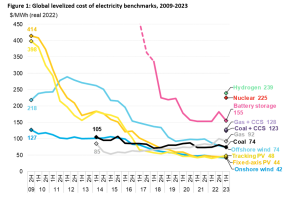London and New York, June 7, 2023 – The costs of wind power and battery energy storage projects have come down from levels seen in 2022, at the height of global supply chain constraints and the impacts of the Ukraine war. The industry still faces challenges as central banks continue to raise rates and some clean energy manufacturers are not yet passing cost savings on to buyers, but the last few years of turmoil have been an exception to otherwise consistent project cost declines over a longer time period according to the latest analysis by research company BloombergNEF (BNEF).
Over the last six months, the costs of new-build offshore wind and storage projects have fallen by a respective 2% and 12% and the global benchmark costs for onshore wind are down 6% over the last 12 months, but remain unchanged since the second half of 2022. BNEF’s analysis shows that the global benchmark levelized cost of electricity, or LCOE, for offshore wind is now on par with coal, the cheapest since BNEF started capturing project data in 2009, driven by a strong China market. Despite a 5% reduction in the cost of fossil fuel-fired projects over the last six months, onshore wind and PV remain the cheapest new-build technologies to produce electricity in countries covering 82% of global electricity generation.
BloombergNEF’s global benchmark costs for solar have risen over the last six months. The average fixed-axis solar project is estimated to be a modest 2% more costly. The typical solar project with trackers has risen by a more substantial 12%. These projects are common in the US, and developers here have faced rising labor, balance of plant and financing costs.

Logistics prices have continued to fall from their record highs, offering a welcome relief to project developers and manufacturers who have struggled under high prices in the last two years. Shipping rates from Asia peaked in September 2021 but are now back to early 2020 levels. Shipping routes from Asia are critical to deliver solar panels, inverters, batteries and other components.
Compared to the end of 2022, equipment costs for fixed-axis solar are down 2% due to lower polysilicon prices, while lower lithium carbonate prices have reduced battery storage equipment costs by 1%. Meanwhile, BNEF analysis shows that equipment costs for onshore wind farms are 3% higher, while offshore wind farms are 1% higher on average. American and European wind turbine manufacturers have still been feeling the effects of the commodity squeeze of the past year.
Financing costs have risen and offset some of the gains from lower equipment costs. The weighted average cost of capital (WACC) for new wind projects is 6.4%, almost 50 basis points higher than last year and puts financing costs back to where they were in 2017. This rise was not matched on the equity side and sponsors have shown restraint so far to increase return rates.
Amar Vasdev, lead author of the report said, “Equity investor interest remains strong and expected rates of return have not increased as fast as interest rates. Renewable power projects are considered a safe asset class and with the right power purchase agreement can even provide a hedge against inflation. As central bank interest rates come down, we may also see a wave of refinancing for the current crop of projects.”
These global cost benchmarks combine a range of country-level estimates that vary according to market maturity, resource availability, project characteristics, local financing conditions and labor costs. The cheapest renewable power projects in the first half of 2023 can be found in China, achieving an LCOE of $23/MWh for best-in-class onshore wind farms, $50/MWh for offshore wind and $31/MWh for fixed-axis PV farms. While costs for onshore and offshore wind have risen outside China, a highly competitive domestic wind turbine manufacturing market has led to continued price declines in the country. Two years ago, China’s offshore wind LCOE was $91/MWh, on par with global costs. Today, China’s typical offshore wind LCOE is $66/MWh – that is $21/MWh less than the rest of the world.
Matthias Kimmel, Head of Energy Economics at BNEF, commented: “China has invested a lot into its local supply chain over the last decade-and-a-half, resulting in a highly active renewables industry with cut-throat competition. The country has long been a leader in solar manufacturing, but now we’re also seeing diverging paths when it comes to cost declines for wind turbines. The US and Europe have lagged behind and now need to play catch-up”.
Still, the last few years of turmoil have been an exception to otherwise consistent project cost declines over a longer time period. The LCOEs of utility-scale solar, onshore and offshore wind have fallen by 58-74% over the decade to 2023, and BNEF expects these cost reductions to continue in the long run thanks to continuing technology improvements, greater economies of scale and reduced financing costs.

Contact
Oktavia Catsaros
BloombergNEF
+1-212-617-9209
ocatsaros@bloomberg.net
About Bloomberg
Bloomberg is a global leader in business and financial information, delivering trusted data, news, and insights that bring transparency, efficiency, and fairness to markets. The company helps connect influential communities across the global financial ecosystem via reliable technology solutions that enable our customers to make more informed decisions and foster better collaboration. For more information, visit Bloomberg.com/company or request a demo.